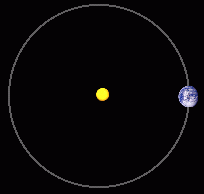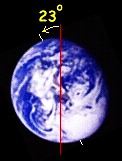 
The seasons on Earth happen as the Earth moves around the Sun. This takes exactly one year. You might be surprised to learn that the Earth's orbit is nearly a perfect circle, so the Earth is about the same distance from the Sun all year long. This means that the seasons do not change because the Earth is getting closer to and further away from the Sun. If this isn't the reason, why is it warmer in summer?  Seasons are caused by the tilt of the Earth. Our planet is tilted at an angle of 23° as it moves around the sun. This causes the northern hemisphere to point towards the Sun (in summer) and away from the Sun (in winter). Here are some bigger pictures so you can more easily see what's happening ...  When it's summer in the northern hemisphere, the top half of the Earth is tilted towards the Sun. This makes the Sun's rays hit the northern regions almost directly. A country like Canada (1) sees the sun nearly overhead, so its rays will be concentrated, making the temperature warm. But the Sun's rays hit the southern hemisphere at an angle, so a country like Argentina (2) will see the sun lower on the horizon, and the light will be spread out more ... temperatures will be cooler.  Six months later, the Earth will be on the other side of the Sun. It will be winter in the northern hemisphere, because the top half of the Earth is now tilted away from the Sun. This makes the Sun's rays hit the northern regions at an angle, so here in Canada (1) we will see the sun lower on the horizon, and the light will be spread out more ... so it will be cooler. But the Sun's rays hit the southern hemisphere almost directly, so Argentina (2) will see the sun nearly overhead, concentrating the rays and making it warm. Another interesting result of the Earth's tilt can be seen if you look closely at the picture just above. Notice that no sunlight hits the North Pole region. This means that during winter in the northern hemisphere, it's dark all day long, and of course all night. The North Pole is in darkness all winter! At the South Pole, however, sunlight hits the Earth continuously as the Earth rotates, so daylight lasts for 24 hours each and every day! When it's summer in the north, the situation is reversed ... the North Pole gets 24 hours of daylight, and the South Pole 24 hours of darkness, every day. We should also mention that these pictures are not drawn to scale, so they don't show the real sizes of and distances between the Earth and the Sun. To get an idea of how big they really are, imagine the Sun were an orange. The Earth would be a grain of sand about 7 metres away! (And the nearest star would be another orange about 3500 kilometres in the distance). |